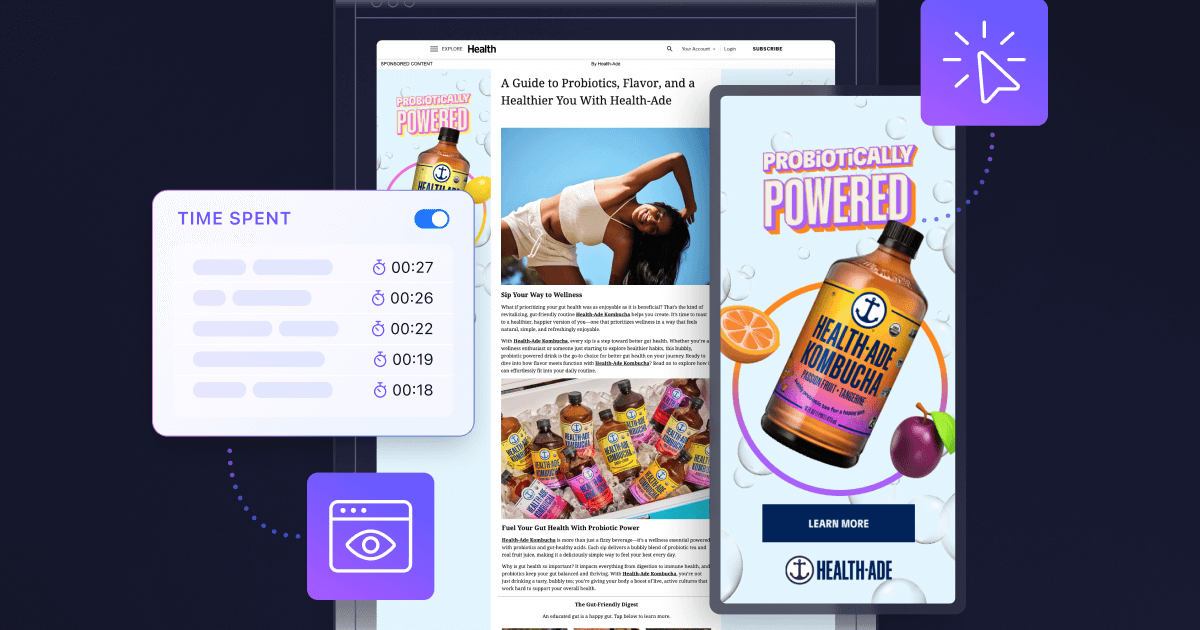Programmatic vs. Native Display Advertising
.png)
Our digital world continues to evolve rapidly, with new methods continuously emerging to captivate audiences. In online advertising, two important but distinct strategies that are employed to deliver ads to consumers are programmatic and native display. Both have their merits, but they serve different purposes and use different mechanisms. In this post we review programmatic and native display advertising, highlighting their distinctive features, benefits, and how they relate to the broader concept of "native advertising".
What is Programmatic Advertising?
Programmatic advertising refers to the automated buying and selling of online ad impressions through real-time auctions. These auctions occur in milliseconds, as a web page is loading. The process uses sophisticated algorithms to determine which ad to show to a user based on various criteria, such as their browsing habits, demographics, and location.
Here's a simplified breakdown of how programmatic advertising works:
- A User Visits a Web Page: When someone clicks on a website that has programmatic advertising enabled, the website sends out a bid request to an ad exchange.
- The Auction Begins: Advertisers who have set up campaigns in the ad exchange will then automatically bid on that impression. The highest bidder wins the opportunity to show their ad.
- Ad Delivery: The winning ad is instantly delivered to the user's browser and displayed on the website they're visiting.
Benefits of Programmatic Advertising
- Efficiency: Advertisers can target specific audiences more accurately, eliminating wasted impressions.
- Real-time Optimization: Adjustments can be made on-the-fly based on immediate data feedback.
- Scale: Advertisers can reach a vast audience across multiple platforms with ease.
What is Native Display?
Native display advertising, often synonymous with native advertising, is a method where ads blend seamlessly into the platform they're on. They don't look or feel like traditional ads. Instead, they appear as part of the content, matching the style, tone, and function of the platform's organic content. As advertisers seek more organic ways to engage users without causing annoyance, native advertising has become a sought-after strategy. It's not about disguising ads, but delivering value in a format that resonates with the audience.
Characteristics of native advertising include:
- Content-Led: Native ads often come in the form of content like articles, videos, or infographics.
- Blends In: It matches the look, feel, and function of the platform it appears on.
- Labeled but Subtle: While native ads blend in, they are usually labeled as "sponsored" or "promoted" to maintain transparency with the audience.
For example, a reader might come across a sponsored post about "10 Best Summer Vacation Spots" on a travel blog. While the content is promotional, it also offers genuine value to the reader, making the advertising aspect secondary. This is the power of native advertising.
Benefits of Native Display Advertising:
- Less Intrusive: Users often find native ads less disruptive than banner ads or pop-ups.
- Higher Engagement: Due to their non-advertorial appearance, native ads tend to have higher click-through rates.
- Builds Trust: Since native ads align with the platform's content, they can enhance trust and brand affinity.
- Bypasses Ad Blockers: Since native ads appear as content, they are less likely to be blocked by ad-blocking software.
Differences Between Programmatic and Native Display
Automation vs. Integration: Programmatic advertising is all about automation and algorithms. It's about buying ad space in real-time and targeting specific audiences. On the other hand, native advertising is more about integrating ads seamlessly into platforms, focusing on content and user experience.
Appearance: Programmatic ads appear as traditional banner ads, video ads, and other standard formats. Native ads, however, are designed to mimic the content and style of the platform they're on.
Purpose: While both programmatic and native display advertising are essential tools in the modern advertiser's arsenal, they serve different functions and cater to varying needs. Programmatic is focused on efficiently buying ad space using automation and reaching the most relevant audience, while native display aims to create ads that provide value and blend organically into the platform's content.
User Experience: While programmatic targets specific audiences, the ad's appearance remains distinct from the platform's content. Native display is designed to enhance user experience by appearing as natural content.
Engagement: While programmatic ads can be targeted efficiently, native ads generally have higher engagement rates because they offer a less disruptive experience.
Cost: Programmatic pricing is dynamic, often based on real-time bidding. Native Display costs might be higher due to the need for high-quality content creation, but it can result in better engagement.
Flexibility: Programmatic offers flexibility in terms of targeting, budgeting, and adjusting campaigns. Native Display requires content that aligns with the platform, which can be less flexible but offers a unique, tailored experience.
Platforms: Programmatic ads are usually found on a wide range of websites, from news sites to blogs. Native ads are often associated with content-rich platforms like news websites, social media, and even podcasts.
Conclusion
Both programmatic and native display advertising have their place in the digital advertising landscape. While programmatic offers efficiency and precise targeting, native advertising focuses on providing a seamless user experience with content-led ads that blend into their surroundings.
Advertisers should understand the strengths and weaknesses of both approaches to make informed decisions based on their goals. Whether you're looking for broad reach and efficient targeting, or higher engagement and a content-focused approach, knowing the difference is crucial in crafting a successful digital advertising strategy.
See what's possible with Nativo. Fill out the form below to schedule a free demo with one of our dedicated experts.

.jpg)


